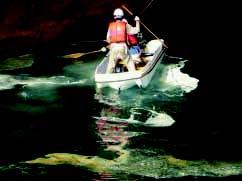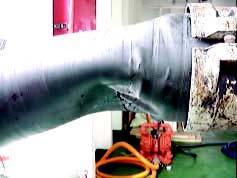200638 Bunkering hazards
A gas tanker was completing cargo operations at night when another cargo vessel bunkering at a berth upwind suffered a ruptured hose and spilled fuel oil into the harbour. The spreading oil quickly coated the harbour installations and the hull of the unfortunate reporting vessel. Her alert deck watch noted the oil on the water at first light, raised the alarm and informed the gas terminal.
Emergency response teams from both the gas tanker and the gas terminal swung into action immediately and directed fire hoses at the slick in an attempt to control its spread. However, this did not prevent some oil staining on the gas tanker's hull. As a result, she was prevented from sailing on schedule pending cleaning of these stains.
Clearly a case of cleaning up someone else's mess and suffering for it as well!
Root cause/contributory factors
1. Bunker hose failure;
2. No oil boom deployed around bunkering vessel;
3. Slow communications among terminals and ships in harbour.
Other valuable lessons
- If practicable, deploy a boom around the vessel during bunkering operations and (as this case illustrates) even if not involved in oil transfers, when berthed near an oil terminal.
- Repeatedly practise ship's emergency and reporting procedures as outlined in the shipboard oil pollution plan (SOPEP) and shipboard marine pollution emergency plan (SMPEP).
- Conduct a realistic spill response and reporting drill before every arrival, including a mock transmission to the appropriate national authority for pollution or spill-related incidents.
- On berthing, brief the crew on the terminal's alerting procedure.
- Inspect transfer hose carefully and reject it if any visible defects seen, despite evidence of a 'proof test'.
- In case of a spill, immediately send initial notification to qualified individual (QI if in US waters), shore facility, harbour / port / national authorities, P&I representative, owners / managers; preserve communication records.
- Prevent escape of spill overside. Although it is impossible to predict what trajectory the fluid may take from a ruptured hose, it may be worth the effort to rig lightweight plastic sheeting under the suspended transfer hose between supply and reception manifolds.
- Wherever possible after the initial report, the master may delegate the task of filing reports to additional parties to a responsible agency or person (QI, local agent, designated person ashore (DPA), P&I correspondent etc).
- Use dispersants or detergents only with the express permission of local authorities.
- Carefully preserve all samples, records, evidence, communication logs and make detailed log book entries of all events. Photographs may be taken if safety and local regulations permit.

Cleaning oil stains from the hull of the gas tanker
Editor's note: On my deck rounds after the bunkering operation had begun on a recent seagoing tour, I was alarmed by the apparent wear and a 'vacuum pinch' on the fuel oil hose. The fuel oil was being taken from a well-maintained barge belonging to a very reputable supplier at one of Europe's best-known bunkering ports. There were tears on the exterior rubber cladding near the end metal coupling and, due to the oil entering a long vertical downward section in the fuel oil line immediately inboard of the ship's manifold a partial vacuum created near the manifold caused a 'pinch' to form in the hose and the pressure gauge to read below zero. The surging oil flow within also caused the hose at this point to flex in and out or 'pant' noisily (see photograph on p 18).
When I pointed this out to the bunkering teams both on board my ship and the barge, I was shown the pressure test date stencilled on the hose (10 months previously) and was assured that the hose was strong enough to withstand these conditions. The other hoses available on the barge were in a worse state. Nevertheless, I ordered the ship's manifold valve to be 'throttled' slightly to ensure the hose always remained in proper shape without creating excessive back-pressure. This did not have any appreciable effect on the transfer rate and I was very glad when the transfer operations ended without incident.

External wear and 'vacuum pinch' on transfer hose
FEEDBACK - JAN 2007 As a chief engineer, a bunkering operation is always a challenging and intense process for me. Bunkering is often carried out when the ship's crew and engineering staff are pressed for both time and manpower and they must be properly trained, briefed and proficient in: pre-bunkering preparation, sampling and measurement during bunkering, post-bunkering operations, contingency plans.
A properly designed bunkering check list will assist in the above. Usually it is required to fill and sign an additional checklist, provided by the supplier, before beginning the bunkering operation.
While the root cause of the spill in the MARS report appeared to be a defective bunker hose, I am sure that in both check lists, the box following the question 'Are the bunker hoses in good condition?' may have just been ticked off without either party capable of ascertaining the actual state of the hose's condition along its full length.
While both the supplier and the ship desire a trouble-free bunkering operation, it is possible that due to commercial and operational pressures, they may overlook minor doubts about a hose's physical appearance, particularly, if a recent test date is visible.
Many scrupulous shipowners or managers arrange for an independent surveyor to verify bunker quality and quantity, and I would suggest that these persons are given the requisite authority to also inspect the hoses before the operation and to prohibit the transfer if the condition of the hoses is unacceptable.
